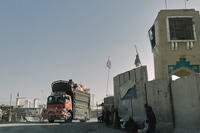Amid an uptick in drone and rocket attacks on U.S. troops in the Middle East, the Pentagon signaled Monday that it is stepping up protections as additional forces are readied and moved into the area -- and also that it is prepared to hold Iran and Iran-backed groups responsible.
A senior defense official, who spoke to reporters Monday about the regional fallout from Israel's bloody war with Hamas, said that they "see a prospect for much more significant escalation against U.S. forces and personnel in the near term and, let's be clear about it, the road leads back to Iran."
The Pentagon's top spokesman, Brig. Gen. Pat Ryder, told reporters at a briefing Monday that there have been a growing number of attacks on U.S. bases in Iraq and Syria -- including one that morning -- in the wake of the war that started earlier this month, and that "by virtue of the fact that they're supported by Iran, we will ultimately hold Iran responsible."
The news of yet another attack on a U.S. installation in the Middle East comes the week after the Pentagon confirmed three other attacks in Iraq and Syria, and the USS Carney destroyer shot down missiles and drones that the department initially said could have been aimed at Israel.
"What has happened in the last several days is efforts by Iran, and Iran proxy forces, to seek to escalate this conflict," the senior defense official said, specifically citing Lebanese Hezbollah and militia groups in Iraq and Syria, as well as the Houthi rebels in Yemen.
The U.S. has surged military forces into the region in support of Israel after it was suddenly attacked by Hamas, the group that rules the Gaza Strip, where about 2.3 million Palestinians live. The Hamas attack included rockets and the deployment of gunmen into Israel who slaughtered Israeli civilians; about 1,400 Israelis were killed.
Israel declared war and has waged a devastating bombing campaign against Gaza in what many believe to be a lead-up to a ground offensive, which could further inflame the region.
The bases in Iraq and Syria were targeted by drones last week. While some personnel were injured in the attacks, so far none has been killed by enemy weapons. However, a U.S. civilian contractor suffered a heart attack while sheltering in response to a false alarm at Iraq's Al Asad Air Base last week and died shortly thereafter.
"We've been under an increase of attacks for the last three days or so at various locations throughout" the Middle East, a senior military official told reporters Monday.
The two officials briefed the Pentagon press corps about the latest developments surrounding the Israel-Hamas war on the condition they would not be named.
The messaging is a shift from the Pentagon's more guarded tone last week when Ryder said he was "not tracking any specific information regarding the specific targeting of American citizens or U.S. military forces or their families."
Meanwhile, the Marine's top officer, Gen. Eric Smith, told a crowd at a memorial for the 40th anniversary of the bombing of the Marine barracks in Beirut that the Marines now deployed to the area "bring with them the weapons of war, if needed" to applause from the crowd.
"For those that are in the area, if that MEU has to go in, if you target them, someone else will raise your children," Smith added, referencing a Marine expeditionary unit -- and using some of the most aggressive language heard from a government official to date.
Pentagon officials are also stressing that the downing of four land-attack cruise missiles and 15 drones by the USS Carney in the Red Sea was a self-protection measure by the ship instead of a move made on Israel's behalf.
"That ship has the inherent right to protect itself, and so as it saw these missiles and these drones, it took them out," Ryder said Monday.
On Thursday, Ryder had said that the initial assessment was that the missiles were possibly headed for potential Israeli targets and wouldn't say whether the threat they posed was to the ship or Israel. He also said that the belief that the missiles were targeting Israel was based largely on the direction of the missiles' flight rather than a deeper understanding of their range or capabilities.
A Navy spokesperson told Military.com that the Carney used SM-2 missiles and its 5-inch gun to destroy the missiles and drones, but wasn't able to say how many rounds were used in the engagement.
In response to the uptick in attacks, the Pentagon has announced that it will not only move more air defense platforms into the region but it has decided to move the USS Dwight D. Eisenhower strike group from its previously assigned mission of supporting deterrence efforts off the Israeli coast and instead have the aircraft carrier, along with three other ships, go to waters off the Arabian peninsula instead -- putting the Navy ships much closer to Iran.
The move, according to Ryder, "enhances our presence and ... provides another level of capability across the broader Middle East region."
Officials have also said that additional troops -- above the 2,000-some service members announced last week -- have been placed on "prepare to deploy orders."
The senior military official said that the additional troops will be "largely command-and-control units" that would give Defense Secretary Lloyd Austin and U.S. Central Command options for "various missions for forces that are already postured there."
"These measures are critical to bolstering regional deterrence efforts, safeguarding our troops and assisting in the defense of Israel," the senior defense official said.
-- Konstantin Toropin can be reached at konstantin.toropin@military.com. Follow him on X at @ktoropin.












